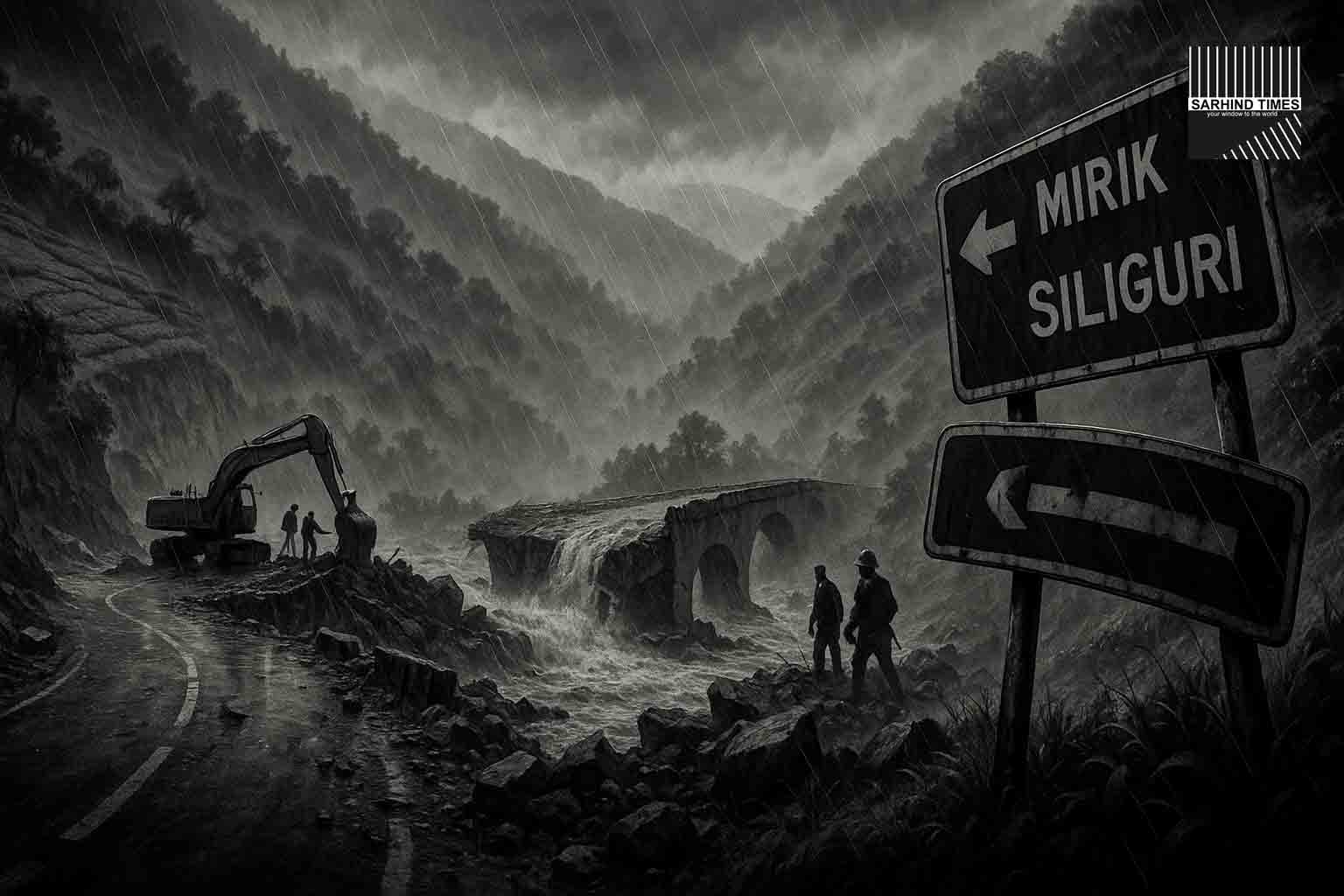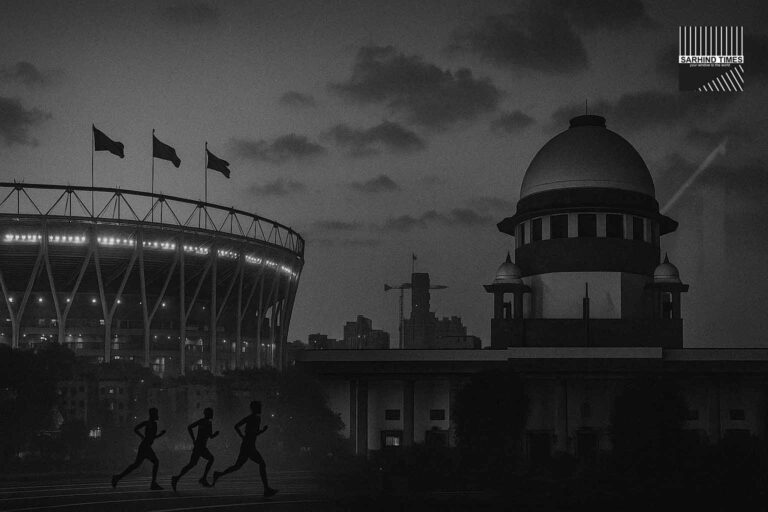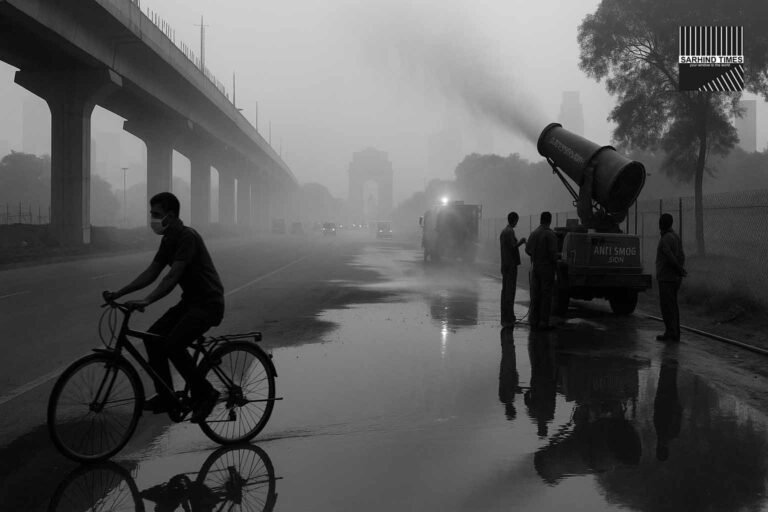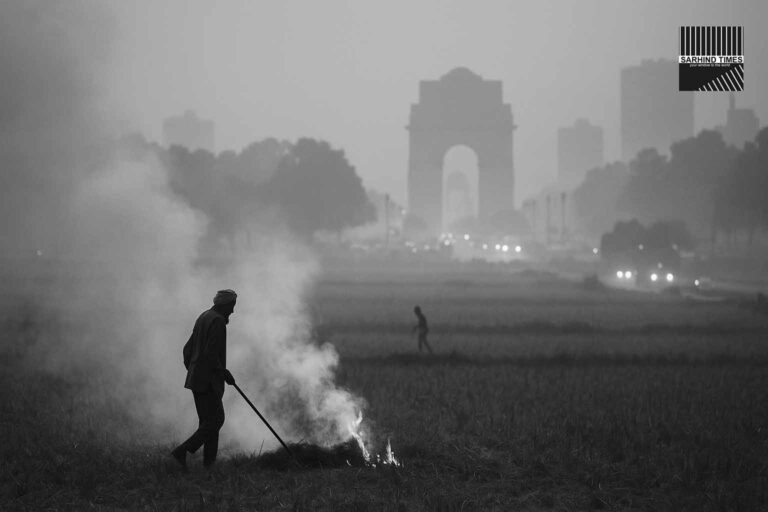A Bay of Bengal system curved north and then back east during monsoon retreat, funneling torrents into the Himalayan foothills; Darjeeling and the Dooars saw cloudbursts, landslides and washed-out bridges as Bhutan’s Tala dam overflow warning heightened risk downstream.
KOLKATA/SILIGURI/DARJEELING | Monday, October 6, 2025
Unseasonal torrents that tore through North Bengal over the weekend—ripping up roads, collapsing bridges and triggering deadly landslides—were driven by an “unexpected recurve” in a Bay of Bengal low-pressure system that veered north–northwest and then turned east-northeast even as the southwest monsoon was in retreat, according to meteorologists. In Darjeeling, 261 mm of rain in 24 hours was logged amid the deluge; multiple deaths were reported and rescue teams fanned out across the hills.
IMD bulletins show the system formed over the west-central Bay, moved inland across Odisha and Jharkhand, then recurved east-northeast from October 6—a track change that re-energised rain bands along the Himalayan foothills and into Sub-Himalayan West Bengal & Sikkim. The agency flagged extremely heavy to very heavy rain risks for Oct 4–6, including North Bihar and the Sub-Himalayan West Bengal & Sikkim belt.
As floodwaters rose, Bhutan’s Tala hydropower dam reported an overflow due to a technical failure, prompting transboundary alerts for Jalpaiguri and Cooch Behar where rivers descend from the hills into the Dooars. Indian authorities placed NDRF units on the highest alert to pre-position rescue assets.
What changed in the sky
A well-marked low-pressure area over eastern India intensified after crossing the coast, then stalled long enough for steering winds to shift with the season. In a late-monsoon/withdrawal window—when synoptic patterns are volatile—the system’s track pivot steered moisture-laden bands into the Darjeeling–Kalimpong–Jalpaiguri–Alipurduar arc and into North Bihar, priming orography to squeeze out hours of very heavy rain. IMD’s national and cyclone bulletins trace this evolution and, crucially, record that from the morning of Oct 6 the system would “recurve and move east-northeastwards,” a trajectory consistent with the deluge footprint.
A PTI/IMD run of alerts through Oct 3–5 had already warned that Sub-Himalayan West Bengal would see heavy to very heavy rain, while Kolkata and parts of South Bengal could catch feeder bands around the system’s southern flank. That came to pass with spells over the metropolis and its estuarine districts even as the worst impacts stayed confined to the north.
A hill country deluge
Through Saturday night and early Sunday, Darjeeling district absorbed a hammering: 261 mm in 24 hours, bridges mangled, stretches of the Mirik–Siliguri lifeline cut, and landslides reported at dozens of points. Initial tallies put fatalities beyond two dozen as rescue parties navigated slumps and slashed roads; the count fluctuated across outlets while teams searched for the missing.
Further east in the Dooars, Banarhat and Nagrakata in Jalpaiguri logged ~350 mm in 12 hours, while Kalchini in Alipurduar faced rising rivers swollen by both local downpours and Bhutan’s runoff. Tea gardens across the belt were inundated, disrupting plucking and threatening a peak-season workforce that lives close to the floodplain.
By Sunday, state agencies flagged washouts and bridge collapses, tourists stranded, and sections of hill highways impassable. Reports described elephant-assisted rescues in cut-off pockets—an emblem of both the terrain’s challenges and the urgency of moving people before slopes destabilised further.
The science of a “recurve” in retreat season
Recurvature is when a low-pressure system changes heading as background winds evolve—common with tropical cyclones, rarer (but impactful) with land-depressions and well-marked lows in India’s shoulder season. In early October, the monsoon trough often breaks up, mid-latitude westerlies begin intruding, and residual Bay moisture lingers. The system that drenched North Bengal rode this handoff: it tracked north–northwest into the interior, then turned east-northeast as westerlies tugged it back, focusing lift over the foothills where orography multiplies rainfall. IMD’s press note explicitly captured the recurve from Oct 6, and its outlooks pegged extremely heavy rain over Sub-Himalayan West Bengal & Sikkim through Oct 4–6.
This is precisely the sort of transition-period punch forecasters warn of: even as monsoon withdrawal proceeds elsewhere, a single Bay system can exploit remnant moisture and steering shifts to deliver high-impact, short-fuse events in the northeast corridor.
Kolkata felt the fringe, but the hills took the hit
City bulletins and media wraps through the week indicated light to moderate showers in Kolkata interlaced with heavier spells, with civic agencies going on alert for waterlogging around Puja hubs. But the rain core sat over North Bengal, Sikkim and North Bihar, as the low slowed and wrapped feeder bands around the foothills.
Bhutan’s Tala dam: river warnings add a second front
Complicating the disaster picture: Bhutan warned that the Tala hydropower dam was overflowing due to a technical fault, pushing surge risk into the Torsa/Raidak systems and downstream Dooars settlements like Hasimara and Toto Para. Indian agencies in Jalpaiguri and Cooch Behar went to high alert; NDRF and district teams staged near river-training stretches and vulnerable footbridges. The transboundary warning arrived as hillside landslides choked roads—an unwelcome confluence for logistics.
Rescue & response: an operations map
State officials, the Army, and NDRF units mounted multi-site rescues across Mirik, Sukhiapokhri, Jorebunglow and flood-prone pockets of the Dooars. Heavy machinery moved to clear 40+ landslide points; priorities included reopening Mirik–Darjeeling links, restoring power to hill wards, and securing water intakes fouled by debris. Search efforts continued Monday amid unstable slopes and intermittent rain.
In the plains, tea estates scrambled to safeguard housing lines and health posts as floodwater entered sections of Banarhat, Nagrakata and Kalchini. The state’s disaster management control room signalled pre-positioned relief and boat teams along low-lying tracts and river bends known to rise fast when Bhutan hills see heavy rain.
Why the foothills amplify risk
Three ingredients turn North Bengal’s sub-Himalayan belt into a flood-and-landslide hotspot during recurves:
- Orographic lift: Moisture-rich south-easterlies slam into stair-step terrain; cumulonimbus towers wring out 100–300 mm bursts over short windows. Darjeeling’s 261 mm/day is in this class.
- Steep, saturated slopes: Even with monsoon retreat underway, soils remain near field capacity; a few hours of intense rain trigger debris flows.
- Tightly coupled rivers: Short, flashy catchments—Teesta, Torsa, Jaldhaka, Raidak—rise swiftly; Bhutan’s dam-overflow alert sharpened that edge for the Dooars.
“200 mm+ and rising”: the data window
Across the belt, gauges captured extreme 12–24 hour totals. In the western Dooars, blocks like Banarhat/Nagrakata logged roughly 350 mm/12h—an extraordinary pulse aggravated by Bhutan hill runoff; further west, Darjeeling saw 261 mm/24h, with reports of washed-out iron bridges severing logistics toward Siliguri. Casualty numbers varied by outlet through Sunday–Monday, but all converged on a high-fatality, high-damage event.
IMD’s press sequence underlined what forecasters expected: “Isolated extremely heavy” for Sub-Himalayan West Bengal & Sikkim on Oct 4–5 and heavy on Oct 6—a three-day hazard arc that maps onto observed impacts.
Voices from the field
Disaster managers told this newspaper that Monday’s priority was opening one secure corridor from Siliguri into Mirik and stabilising slope toes abutting the roadway; crews were instructed to avoid secondary cuts that might slump again in residual showers. Hydrologists emphasised catchment management—clearing culverts, restoring drainage networks blocked by landslide debris, and early-warning dissemination along hill streams that can jump one to two metres in minutes. These operational notes track with recent advisories as the state readied for heavy rain from Oct 1 onward.
Kolkata & the lowlands: staying ahead of banding
Kolkata’s civic machinery went on a pre-alert as the low spun feeder bands across South Bengal: sand-bagging vulnerable pumps, clearing drains around Puja pandals, and advising commuters to avoid underpasses during cloudbursts. While the city escaped the hills’ severity, short, intense cells rotated in through the weekend and early week, consistent with IMD guidance.
Climate signal or caprice? What experts say
It is tempting to badge every shock as climate-driven, yet attribution needs careful study. Still, scientists have repeatedly warned that a warmer ocean-air system loads the dice for heavier downpours and stalled or odd-track systems during shoulder seasons. International wire and domestic analyses on Monday placed the North Bengal deluge within a broader run of extreme monsoon events across South Asia this year. The recurve in a retreat window, and the east-northeast swing back toward the foothills, fit that pattern.
What to watch (next 72 hours)
- Drain-down & slope stability: As the system weakens east-northeast, watch for secondary landslides on freshly cut slopes—often triggered by seepage rather than new rain.
- River stage updates: Torsa/Raidak/Teesta levels in the Dooars; officials are coordinating with Bhutan for hydrological data as Tala’s status evolves.
- Connectivity: Progress on Mirik–Siliguri and Darjeeling–Sukhiapokhri corridors; restoration of power and telecom in multiple hill wards.
- Weather window: IMD outlooks indicated heavy risk tailing off by Oct 6 for Sub-Himalayan WB, with northwesterlies promoting a cool-down later this week.
Reader’s guide: flood & landslide safety in hill–plain systems
If you’re in the hills (Darjeeling/Kalimpong belts):
- Do not re-enter houses with new wall cracks, tilting plinths or fresh water seep lines.
- Avoid walking on saturated slope edges and along cut faces beside roads.
- Use official shelters if your home sits below a recent slide or above an active undercut.
- Travel only in daylight and only if the district administration has cleared the route.
If you’re in the plains (Dooars/Jalpaiguri/Alipurduar):
- Park vehicles on higher ground; avoid river bends with history of sudden level rises.
- Do not wade through fast, opaque water; avoid bridges when rivers are in spate—overtopping can happen within minutes during hill surges.
- Keep battery lights, drinking water, prescriptions ready; charge phones and power banks.
Information hygiene: Follow IMD and district disaster handles, not forwarded “dam burst” rumours.
Explainer: Why October still bites
Monsoon withdrawal isn’t a switch; it’s a staggered retreat. Moisture lingers over the Bay; the monsoon trough breaks up; and westerlies begin their winter march. The atmosphere can thus support hybrid synoptics—Bay lows interacting with mid-latitude waves—that direct rain to places not primed for it. Kolkata’s October rain is a familiar festival-season trope; what’s different in 2025 is the recurve into the foothills during an active warning window.
#BengalFloods #Monsoon #IMD #Climate #DisasterResponse #Darjeeling #Kolkata #Weather
























+ There are no comments
Add yours